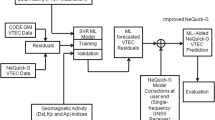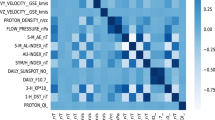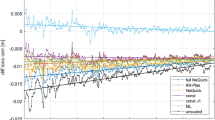Abstract
Total Electron Content (TEC) is the integral of the electron density along the path between receivers and satellites. TEC measured from Global Navigation Satellite Systems (GNSS) data is valuable to monitor space weather and correct ionospheric models. TEC noise detection is also an essential channel to forecast space weather and research the relationship between the atmosphere and natural phenomena like geomagnetic storms, earthquakes, volcanos, and tsunamis. In this study, we apply optimization machine learning techniques and integrated GNSS and solar activity data to determine GNSS-TEC noise at the International GNSS Service (IGS) stations in the Tonga volcanic region. We investigate 38 indices related to the geomagnetic field and solar wind plasma to select the essential parameters for forecast models. The findings show the best-suited parameters to predict vertical TEC time series: plasma temperature (or Plasma speed), proton density, Lyman alpha, R sunspot, Ap index (or Kp, Dst), and F10.7 index. Applying the Ensemble algorithm to build the TEC forecast models at the investigated IGS stations gets the accuracy from 1.01 to 3.17 TECU. The study also shows that machine learning combined with integrated data can provide a robust approach to detecting TEC noise caused by seismic activities.
Access this chapter
Tax calculation will be finalised at checkout
Purchases are for personal use only
Similar content being viewed by others
References
Nathan, B., Christos, C.: Radio propagation and adaptive antennas for wireless communication links: terrestrial, atmospheric and ionospheric. Wiley, Hoboken, New Jersey (2007)
Robert, D.H., Jonh, K.H.: The high-latitude ionosphere and its effects on radio propagation. Cambridge University Press, New York (2003)
Hornbostel, A.: Propagation problems in satellite navigation. Proc. WFMN07 Chemnitz Ger., pp. 42–49, (2007). Retrieved from http://archiv.tu-chemnitz.de/pub/2007/0210/
Medžida, M., Natraš, R., Džana, H., Dževad, K.: Investigation of ionospheric variations and sudden disturbances as a source of GNSS errors and earthquake precursor. Sci. J. Civ. Eng. (2017). Retrieved from https://publik.tuwien.ac.at/files/publik_270748.pdf
Meyer-Vernet, N.: Basics of the Solar Wind. The United States of America by Cambridge University Press, New York (2007)
Gurnett, D.A., Amitava, B.: Introduction to Plasma Physics with Space and Laboratory Applications, vol. 17997, no. 383 (2017)
Hoffert, M.I.: The effects of solar variability on climate, vol. 19, no. C. The National Academies Press, Washington, D.C. (2012)
Ninla Elmawati Falabiba: The sun solar wind heliosphere. Springer, Dordrecht Heidelberg London New York (2019)
**, S., **, R., Liu, X.: GNSS Atmospheric Seismology. Springer Nature Singapore Pte Ltd. (2019)
Huang, C.Y., Helmboldt, J.F., Park, J., Pedersen, T.R., Willemann, R.: Ionospheric detection of explosive events. Rev. Geophys. 57(1), 78–105 (2019). https://doi.org/10.1029/2017RG000594
Obayashi, T.: Upper atmospheric disturbances due to high altitude nuclear explosions. Planet. Space Sci. 10, 47–63 (1963). https://doi.org/10.1016/0032-0633(63)90006-0
Park, J., Grejner-Brzezinska, D.A., Von Frese, R.R.B., Morton, Y., Gaya-Pique, L.R.: On using traveling ionospheric disturbances to detect underground nuclear tests. Inst. Navig. Int. Tech. Meet. (ITM) 2, 1581–1589 (2012)
Mabie, J., Bullett, T., Moore, P., Vieira, G.: Identification of rocket-induced acoustic waves in the ionosphere. Geophys. Res. Lett. 43(20), 11024–11029 (2016). https://doi.org/10.1002/2016GL070820
Lin, C.H., et al.: Ionospheric shock waves triggered by rockets. Ann. Geophys. 32(9), 1145–1152 (2014). https://doi.org/10.5194/angeo-32-1145-2014
Heki, K., Fujimoto, T.: Atmospheric modes excited by the 2021 August eruption of the Fukutoku-Okanoba volcano, Izu–Bonin Arc, observed as harmonic TEC oscillations by QZSS. Earth Planets Sp., 74(1) (2022). https://doi.org/10.1186/s40623-022-01587-5
Hasbi, A.M., et al.: Ionospheric and geomagnetic disturbances during the 2005 Sumatran earthquakes. J. Atmos. Solar Terr. Phys. 71(17–18), 1992–2005 (2009). https://doi.org/10.1016/j.jastp.2009.09.004
Pulinets, S.A., Legen’ka, A.D., Hegai, V.V., Kim, V.P., Korsunova, L.P.: Ionosphere disturbances preceding earthquakes according to the data of ground based station of the vertical ionospheric sounding wakkanai. Geomagn. Aeron. 58(5), 686–692 (2018). https://doi.org/10.1134/S0016793218050110
Korsunova, L.P., Khegai, V.V.: Possible short-term precursors of strong crustal earthquakes in japan based on data from the ground stations of vertical ionospheric sounding. Geomagn. Aeron. (2018). https://doi.org/10.1134/S0016793218010085
Shi, K., Liu, X., Guo, J., Liu, L., You, X., Wang, F.: Pre-earthquake and coseismic ionosphere disturbances of the Mw 6.6 Lushan earthquake on 20 April 2013 monitored by CMONOC. Atmos. (Basel) 10(4), 1–21 (2019). https://doi.org/10.3390/ATMOS10040216
Zlotnicki, J., Li, F., Parrot, M.: Ionospheric disturbances recorded by DEMETER satellite over active volcanoes: from august 2004 to december 2010. Int. J. Geophys. 2013 (2013). https://doi.org/10.1155/2013/530865
Ishii, M.: Extreme Space Weather Research in Japan, vol. 1957. Elsevier Inc. (2018)
Akyol, A.A., Arikan, O., Arikan, F.: A machine learning-based detection of earthquake precursors using ionospheric data. Radio Sci. 55(11), 1–21 (2020). https://doi.org/10.1029/2019RS006931
Sharma, G., Champati ray, P.K., Mohanty, S., Kannaujiya, S.: Ionospheric TEC modelling for earthquakes precursors from GNSS data. Quat. Int. 462, 65–74 (2017). https://doi.org/10.1016/j.quaint.2017.05.007
Ulukavak, M., Yalcinkaya, M.: Precursor analysis of ionospheric GPS-TEC variations before the 2010 M7.2 Baja California earthquake. Geomatics Nat. Hazards Risk, 8(2), 295–308 (2017). https://doi.org/10.1080/19475705.2016.1208684
Goto, S.I., Uchida, R., Igarashi, K., Chen, C.H., Kao, M., Umeno, K.: Preseismic ionospheric anomalies detected before the 2016 Taiwan earthquake. J. Geophys. Res. Sp. Phys. 124(11), 9239–9252 (2019). https://doi.org/10.1029/2019JA026640
Tariq, M.A., Shah, M., Hernández-Pajares, M., Iqbal, T.: Pre-earthquake ionospheric anomalies before three major earthquakes by GPS-TEC and GIM-TEC data during 2015–2017. Adv. Sp. Res. 63(7), 2088–2099 (2019). https://doi.org/10.1016/j.asr.2018.12.028
Nina, A. et al.: Variation in natural short-period ionospheric noise, and acoustic and gravity waves revealed by the amplitude analysis of a VLF radio signal on the occasion of the Kraljevo earthquake (Mw = 5.4). Sci. Total Environ. 710, 136406 (2020). https://doi.org/10.1016/j.scitotenv.2019.136406
Zhao, S., Shen, X.H., Zhima, Z., Zhou, C.: The very low-frequency transmitter radio wave anomalies related to the 2010 Ms 7.1 Yushu earthquake observed by the DEMETER satellite and the possible mechanism. Ann. Geophys. 38(5), 969–981 (2020). https://doi.org/10.5194/angeo-38-969-2020
Sun, W. et al.: Forecasting of ionospheric vertical total electron content (TEC) using LSTM networks. Proc. 2017 Int. Conf. Mach. Learn. Cybern. (ICMLC) 2, 340–344 (2017). https://doi.org/10.1109/ICMLC.2017.8108945
Liu, L., Zou, S., Yao, Y., Wang, Z.: Forecasting global ionospheric TEC using deep learning approach. Sp. Weather 18(11), 1–12 (2020). https://doi.org/10.1029/2020SW002501
Ruwali, A., Kumar, A.J.S., Prakash, K.B., Sivavaraprasad, G., Ratnam, D.V.: Implementation of hybrid deep learning model (LSTM-CNN) for ionospheric TEC forecasting using GPS data. IEEE Geosci. Remote Sens. Lett. 18(6), 1004–1008 (2021). https://doi.org/10.1109/LGRS.2020.2992633
Cesaroni, C. et al.: Neural network based model for global total electron content forecasting. J. Sp. Weather Sp. Clim. 10 (2020). https://doi.org/10.1051/swsc/2020013
Lin, X. et al.: A Spatiotemporal Network Model for Global Ionospheric TEC Forecasting (2022)
Heki, K.: Advances in Ionospheric Research: Current Understanding and Challenges - Ionospheric Disturbances Related to Earthquakes. Wiley/AGU Online Library (2021)
Mallika, L.I., Ratnam, D.V., Raman, S., Sivavaraprasad, G.: Machine learning algorithm to forecast ionospheric time delays using Global Navigation satellite system observations. Acta Astronaut. 173, 221–231 (2020). https://doi.org/10.1016/j.actaastro.2020.04.048
Zhukov, A., Sidorov, D., Mylnikova, A., Yasyukevich, Y.: Machine learning methodology for ionosphere total electron content nowcasting. Int. J. Artif. Intell. 16(1), 144–157 (2018). https://doi.org/10.13140/rg.2.2.19349.83685
Global Volcanism Program | Raikoke. Retrieved from https://volcano.si.edu/volcano.cfm?vn=290250
Ripple effect_ What the Tonga eruption could mean for tsunami research _ National Oceanic and Atmospheric Administration. Retrieved from https://volcano.si.edu/volcano.cfm?vn=243040
GEOFON Program GFZ Potsdam: 9C Seismic Network. Retrieved from http://geofon.gfz-potsdam.de/eqinfo/list.php?datemin=2022-01-15&datemax=2022-01-15&latmax=&lonmin=&lonmax=&latmin=&magmin=&fmt=html&nmax=
Stoica, P., Moses, R.L.: Spectral Analysis of Signals, vol. 4, no. 1. Pearson Prentice Hall (2005)
Welch, P.: The use of fast Fourier transform for the estimation of power spectra: a method based on time averaging over short, modified periodograms. IEEE Trans. Audio Electroacoust. 15(2), 70–73 (1967). https://doi.org/10.1109/TAU.1967.1161901
Lilly, J.M.: Element analysis: a wavelet-based method for analyzing time-localized events in noisy time series. Proc. R. Soc. A Math. Phys. Eng. Sci. (2017). https://doi.org/10.1098/rspa.2016.0776
Lilly, J.M., Olhede, S.C.: Generalized morse wavelets as a superfamily of analytic wavelets. IEEE Trans. Signal Process. 60(11), 6036–6041 (2012). https://doi.org/10.1109/TSP.2012.2210890
Hudson, T.S., Horseman, A., Sugier, J.: Diurnal, seasonal, and 11-yr solar cycle variation effects on the virtual ionosphere reflection height and implications for the Met Office’s lightning detection system, ATDnet. J. Atmos. Ocean. Technol. 33(7), 1429–1441 (2016). https://doi.org/10.1175/JTECH-D-15-0133.1
Zheng, W., et al.: Diurnal, seasonal, annual, and semi-annual variations of ionospheric parameters at different latitudes in East Asian sector during ascending phase of solar activity. Solar Terr. Phys. 3(2), 45–53 (2017). https://doi.org/10.12737/22594
Author information
Authors and Affiliations
Corresponding author
Editor information
Editors and Affiliations
Rights and permissions
Copyright information
© 2023 The Author(s), under exclusive license to Springer Nature Switzerland AG
About this paper
Cite this paper
Le, N., Männel, B., Bui, L.K., Jarema, M., Nguyen, T.C., Schuh, H. (2023). Detection of GNSS-TEC Noise Related to the Tonga Volcanic Eruption Using Optimization Machine Learning Techniques and Integrated Data. In: Nguyen, L.Q., Bui, L.K., Bui, XN., Tran, H.T. (eds) Advances in Geospatial Technology in Mining and Earth Sciences. GTER 2022. Environmental Science and Engineering. Springer, Cham. https://doi.org/10.1007/978-3-031-20463-0_9
Download citation
DOI: https://doi.org/10.1007/978-3-031-20463-0_9
Published:
Publisher Name: Springer, Cham
Print ISBN: 978-3-031-20462-3
Online ISBN: 978-3-031-20463-0
eBook Packages: Earth and Environmental ScienceEarth and Environmental Science (R0)




